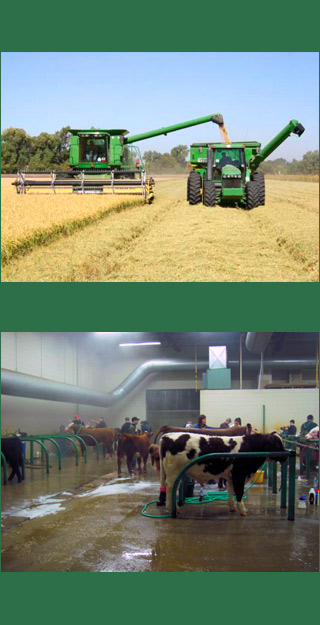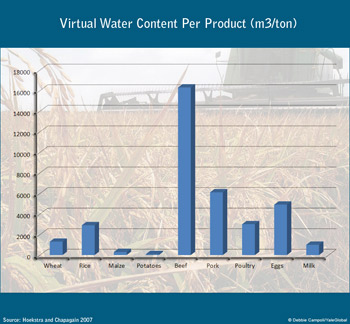The Hidden Global Trade in Water
The Hidden Global Trade in Water

MILWAUKEE: In all the anguished discussion about the planet’s water shortages, one often does not hear of the water traveling across oceans, locked in sacks and cartons of food. Food exports hide the significant global trade in water, which could be made transparent and reorganized to reduce water-stress and increase global food security.
Several of the most water-scarce regions of the world are producing the most water-intensive crops – for example, water-intensive rice grown in arid parts of Australia, Mexico and the American West for export to Asia or Europe. Many of these water-intensive crops are traded in the international food market along with their water content and water consumed in the production process. The trade is now referred to as virtual water exports and constitutes a net loss of water from water-scarce regions.
Virtual water is the amount of embedded water used to produce agricultural and industrial goods. Calculations of global water trade by the international institute for water education, UNESCO-IHE 2003 estimated that 1,040 billion square meters of virtual water are traded each year at the global level. This trade could be reorganized for water-scarce regions to become virtual importers, a reversal of their current net loss, and water-rich regions to become virtual exporters.

The reality is that it takes more water overall to produce water-intensive crops in water-scarce regions. This constitutes an inefficient use of water. For example, it requires twice as much water to produce grain in water-scarce regions as in water-rich regions: A 2005 study by A.Y. Hoekstra and P.Q. Hung suggests that producing 1 kilogram of grain in favorable climactic conditions requires up to 2000 kilograms of water; the same amount in an arid country requires up to 5000 kilograms. The difference is due largely to high temperature, high evaporation, soil conditions and other climate factors.
These dynamics will become more consequential as water scarcity increases and can only be resolved by global coordination.
Water scarcity and food security are inextricably linked. Agriculture is the largest water-user, requiring about 70 percent of all water used for human production and consumption. For example, it takes approximately 500 liters of water to produce one cup of rice and 4,500 liters of water to produce a 300-gram serving of beef, according to a 2007 study by Hoekstra and A. Chapagain. Examples of virtual water content are given in Figure 1. Virtual water is considered a consumptive-use, meaning it’s not returned to its local hydrological system, often resulting in a net water loss from the region when the products are exported. This emerging and under-researched concept will gain prominence as water scarcity becomes more pronounced and virtual water exports exacerbate scarcity, food insecurity, loss of national income. The imbalances could subsequently decrease political stability and stunt economic prosperity.
Approximately one fourth of all water used in production is traded through water-intensive commodities in the international market. In short, this means that one fourth of water use is exported as virtual water. The amount is even higher in countries that are large food and grain exporters. For example, the United States exports approximately one third of its total water withdrawal in the country, according to UNESCO-IHE 2003. Examples of net virtual water exporters are given in Figure 2. The scale of the virtual water trade is expected to increase as global demand for food increases with population growth and economic development.

Water-scarce regions can mitigate food shortages and improve water-use efficiency by importing agricultural products with high virtual water content and exporting products with low virtual water content. Yet the opposite is the current reality: Water-scarce regions are overwhelmingly producing and exporting water-intensive products. For example, arid parts of Egypt, Turkey and Eastern Europe, including the Aral Sea region, have produced large quantities of water-intensive cotton for export to Asia and Europe. This is, in large part, a function of the development of cash crop exports for water-scarce countries that are almost entirely dependent on primary commodities. It’s also a function of short-term economic planning for rapid growth, perverse water and energy subsidies, and shortsighted use of methods exceeding ecological limits. These dynamics result in inefficiency.
Yet international water-use inefficiencies are not a fait accompli. International water trade and food production can be improved by applying the concept of comparative advantage to decisions about importing versus exporting water-intensive food crops. Water-scarce countries should import water-intensive grains and export products with less virtual water content. Based on scarce land and water resources, Singapore and Malaysia have used the international food market to import water-intensive grains and meats, and they export mostly non-agricultural value-added manufactured goods. This allows them to maintain food security while harnessing their scarce water resources for competing uses.
At the international level, water-use efficiency and food security can be improved by adjusting to the new information and emerging realities. The virtual water-flows in the international economy are measured as net water gain or net water loss in global water-use efficiency. A net water loss, for example, would occur if a water-intensive grain were being produced in a water-scarce country, which is often the case, where its production requires the most water. The net water loss would be evident in two ways: First, the water-scarce country would be exporting virtual water, which constitutes a domestic net water loss. Second, it would decrease global water-use efficiency because it requires more water overall to produce certain crops in water-scarce regions.
Correcting inefficiency in global water-use will require substantial international coordination. A high level of cooperation is possible in this area, as the food crop trade is globalized and food security highly interdependent. It’s the dearth of information about the hidden water trade and the current lack of international coordination that allow global water-use inefficiencies to persist. The Food and Agriculture Organization of the United Nations and the Organisation for Economic Co-operation and Development are best suited to provide information about global water-use efficiency and coordinate the world’s large food producers and consumers. Both have experience coordinating efforts to improve global food security through the international market, but as of yet have not taken on the challenge of coordinating the hidden global water trade.
In conclusion, the new conceptual framework of virtual water can inform and improve global water-use efficiency. A number of countries already experience water shortages and food deficiencies, exacerbated by the hidden water trade, and that number will only increase with climate change and population growth. Calculation of virtual water exports provides valuable information to support strategies to adjust virtual water balances at domestic and international levels. To this end, new analysis of virtual water can be used to mitigate water scarcity and achieve food security, and improve overall global water-use efficiency. We must look for the water hiding in plain sight.
References
Hoekstra, A.Y. and Chapagain, A. 2007. “Water footprints of nations: water use by people as a function of their consumption pattern.” Water Resources Management, Vol. 21: 35-48.
Hoekstra, A.Y. and Hung, P.Q. 2005. “Globalisation of water resources: international virtual water flows in relation to crop trade.” Global Environmental Change, Vol. 15: 45-56.
UNESCO-IHE, Institute for Water Education. 2003. Session C1: Virtual Water Trade and Geopolitics, World Water Forum III, Monday, March 17, 2003, Kyoto, Japan.
Wichelns, Dennis. 2003. “The role of public policies in motivating virtual water trade, with an example from Egypt,” in Hoekstra (editor) Virtual Water Trade: Proceedings of the International Expert Meeting on Virtual Water Trade, Report Series No.12. Delft, The Netherlands: IHE Institute for Water Education, 147-158.